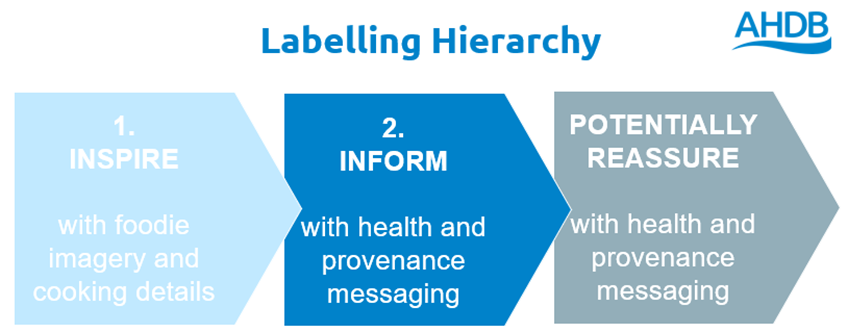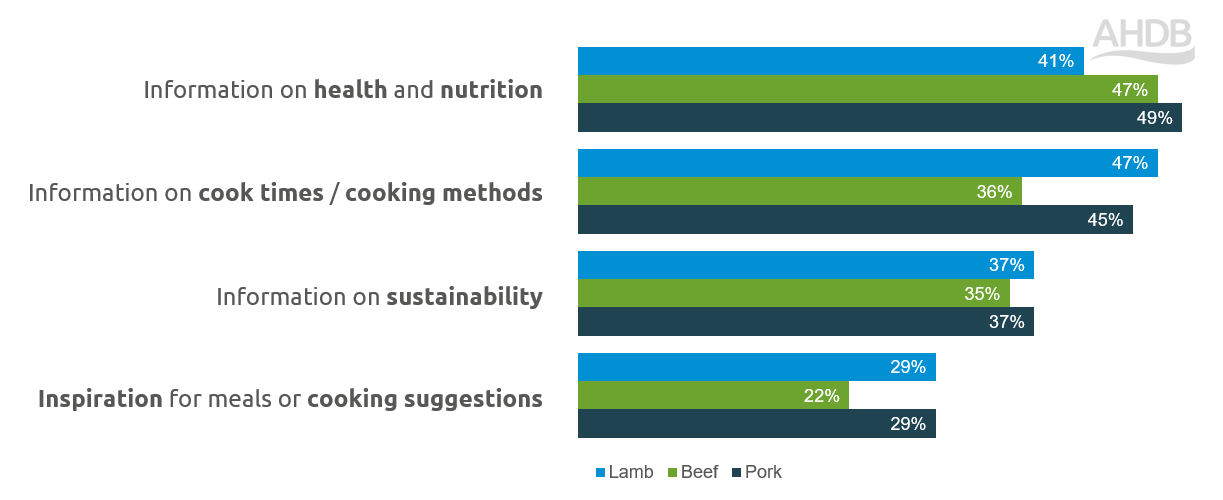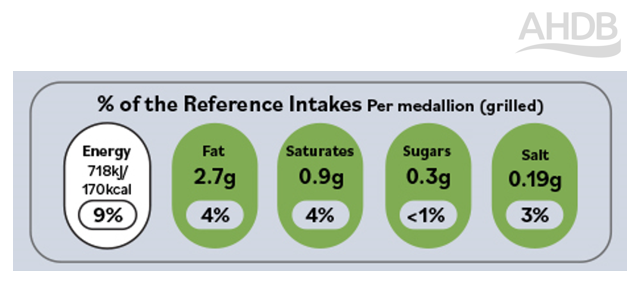- Home
- Hierarchy level 2 – Inform on health
Hierarchy level 2 – Inform on health
After shoppers have been tempted by the tasty food imagery, they like to be able to make an informed choice on the kind of meat they buy. There were two key pieces of information shoppers were looking for around health and provenance.

Health is a big draw for shoppers, and health related information can often make them want to pick up the product and buy it. The multiple benefits of red meat, particularly around natural, low fat and vitamins and minerals, were popular with consumers.
Animal provenance and welfare is not necessarily a driver of purchase; however issues can arise if this information is missing. Shoppers also found it useful when the origin of the product was highlighted, and logos for assurance schemes were included. Information on animal housing and grazing was also seen as particularly beneficial for consumers.
In the final stage of our research, health came out top for information shoppers wanted to see on pack. Health and nutritional information were particularly important for pork, but also the most important for beef.
However, cooking information was most important for lamb, as shoppers are less familiar with cooking it.
What is the most useful for you on pack?

Health is an important consideration for regular meat eaters as well as those who are cutting back on their meat consumption or eating it less frequently. This means it has great appeal across a range of shoppers.
In particular, shoppers find information on the calorie and fat content of meat useful, so even though it’s a legal requirement to have nutritional tables on the pack, we believe it’s a useful thing to highlight to shoppers.


I look at the fat content. This is important to me, because meat high in fat can lead to health problems down the line, especially for some of us who are avid meat eaters. Shopper respondent

The shopper desire to see fat content was particularly important for beef mince, but shoppers would like it to be highlighted more across other low fat cuts.

When shopping for mince beef, I look for the least amount of fat content and a better cut so like mince steak instead of standard mince beef. Shopper respondent

During the final stage of the research, 20 different packs were tested with shoppers. Packs with health messaging saw improved perceptions for a number of image statements including convenient, exciting, tasty, high quality and relevant. Exciting saw the biggest uplift for packs with health messaging, up 7% points.
As previously covered in the inspiration section, the pork medallions pack tested had the biggest gap in appeal compared to the others, and this is likely because it combines the tasty meal with a very strong health message. The fact that pork containing 9 vitamins and minerals was a key message for shoppers and this pack saw the highest level of agreement that the label gave shoppers all the health information they needed (69%) and saw the biggest uplift versus the baseline (+27% points).

Lean and low fat was the most positively received health message. Vitamin B12 and protein were also engaging messages.
Which of the below messages would encourage you to make a purchase? (of those interested in health messaging)
|
Lean and low in fat |
73% |
|
Vitamin B12 content to help the immune system work normally |
51% |
|
Protein content to maintain normal bones |
48% |
|
Iron content to reduce tiredness and fatigue |
47% |
|
Naturally low in sodium |
39% |
|
Vitamin B6 content to help the nervous system work normally |
37% |
|
Vitamin B3 content to help the nervous system work normally |
36% |
|
Zinc content helps with normal cognitive function |
32% |
From other AHDB research, the 9 vitamins and minerals message for pork was particularly compelling for shoppers, but the 8 vitamins for beef and 7 for lamb have also performed strongly. There are many limitations and expenses for processors including this type of messaging on pack, as all the vitamins then have to be listed in the nutrition table on the back. Therefore, it was only included on the one pack here to test how much impact it could have with shoppers.
When showing all the vitamins and minerals contained within meat, some consumers were concerned that these had been artificially added. Therefore, making it clear that the vitamins and minerals within meat are natural is essential.

Looks like it is having vitamins added to the product. Shopper respondent

Results from the in-store research found that when a pack had health messaging, basket size increased by 4%.
From the in-store research, messaging which contains vitamins and minerals but also gave the benefits of those vitamins and minerals performed best and this came through again in this study.

I like it, particularly because it doesn’t just list random vitamins but gives some indication of the impact. Shopper respondent

In the online community consumers were asked about health logos. The logos currently used by Waitrose and M&S were shown to consumers. In general shoppers didn’t particularly like these, as while some found the protein claim useful, most thought they were stating the obvious or didn’t give enough details. Therefore, health logos were not used in the final stage of the research as they don’t have a big enough impact on purchase intent.
Health summary:
- Highlight products which are lean or low in fat
- Adding all the vitamins and minerals contained to the pack such as “Naturally contains 9 vitamins and minerals”
- But also finding the balance where you can give the benefits of the vitamins and minerals
- A learning was to make it clear all the health benefits are natural and not artificially added
- Shoppers like the nutrition table and being able to see the calories and fat content in particular
- Health logos were not seen as useful for most consumers


Sign up to receive the latest information from AHDB.
While AHDB seeks to ensure that the information contained on this webpage is accurate at the time of publication, no warranty is given in respect of the information and data provided. You are responsible for how you use the information. To the maximum extent permitted by law, AHDB accepts no liability for loss, damage or injury howsoever caused or suffered (including that caused by negligence) directly or indirectly in relation to the information or data provided in this publication.
All intellectual property rights in the information and data on this webpage belong to or are licensed by AHDB. You are authorised to use such information for your internal business purposes only and you must not provide this information to any other third parties, including further publication of the information, or for commercial gain in any way whatsoever without the prior written permission of AHDB for each third party disclosure, publication or commercial arrangement. For more information, please see our Terms of Use and Privacy Notice or contact the Director of Corporate Affairs at info@ahdb.org.uk © Agriculture and Horticulture Development Board. All rights reserved.

